Remote Sensing Archaeology of the Xixia Imperial Tombs: Analyzing Burial Landscapes and Geomantic Layouts
Abstract
1. Introduction
1.1. Archaeological and Historical Backgrounds
1.2. Optical Satellite Remote Sensing in Archaeology
1.3. Archaeological Remote Sensing for the Burial Landscape
2. Study Area
2.1. Ancient Xingqing
2.2. The Archaeological Areas of the Xixia Imperial Tombs (XITs)
3. Data and Methods
3.1. Optical Satellite Remote Sensing Data and Preprocessing
3.1.1. Declassified GAMBIT Spy Satellite Photographs
3.1.2. Gaofen Satellite Imagery
3.1.3. Landsat-5 TM and Landsat-8 OLI Data
3.1.4. Google Earth VHR Imagery
3.1.5. Digital Elevation Model (DEM)
3.2. Data Fusion
3.3. Spectral Indices
3.4. Automated Identification of the XITs and Their Subordinate Tombs
4. Results and Discussion
4.1. Remote Sensing Interpretation of the Supporting Environment of the XITs
4.2. Imperial Mausoleums in the XITs
4.3. Subordinate Tombs in the XITs
4.4. Top View and Geometric Characteristics of the Imperial Mausoleum
4.5. Landscape Planning and Geomantic Considerations of the Imperial Mausoleum
4.6. Proposed Location of the Lost Ninth Imperial Mausoleum
5. Conclusions
Author Contributions
Funding
Data Availability Statement
Acknowledgments
Conflicts of Interest
References
- McGrath, M.C. Frustrated Empires: The Song-Tangut Xia War of 1038–1044. In Battlefronts Real and Imagined: War, Border, and Identity in the Chinese Middle Period; Wyatt, D.J., Ed.; Palgrave Macmillan US: New York, NY, USA, 2008; pp. 151–190. [Google Scholar]
- Takayasu, S. Defense Challenges for the Capital of the Xi Xia (Tangut) Kingdom: Evidence from Research on Khara-Khoto Documents from around 1210. Cent. Asiat. J. 2014, 57, 201–208. [Google Scholar]
- Jisheng, X. The Murals of Mogao Cave 465: New Evidence for 12th Century Tangut Xia Patronage. Orientations 2004, 35, 38–45. [Google Scholar]
- Solonin, K.J. Buddhist Connections between the Liao and Xixia: Preliminary Considerations. J. Song-Yuan Stud. 2013, 43, 171–219. [Google Scholar] [CrossRef]
- Wyatt, D.J. (Ed.) Battlefronts Real and Imagined; Palgrave Macmillan US: New York, NY, USA, 2008. [Google Scholar]
- Jing, X. A Study of The Costume Culture of The Xixia’s Donors at Dunhuang Grottoes. Dunhuang Res. 2007, 24–31. [Google Scholar]
- Beckwith, C.I. Empires of the Silk Road: A History of Central Eurasia from the Bronze Age to the Present; Princeton University Press: Princeton, NJ, USA, 2009. [Google Scholar]
- Di Cosmo, N.; Wyatt, D.J. (Eds.) Political Frontiers, Ethnic Boundaries and Human Geographies in Chinese History; Routledge: Oxfordshire, UK, 2005. [Google Scholar]
- Kepping, K.B.; van Driem, G. The Name of the Tangut Empire. T’oung Pao 1994, 80, 357–376. [Google Scholar] [CrossRef]
- Steinhardt, N.S. The Tangut Royal Tombs near Yinchuan. Muqarnas 1993, 10, 369–381. [Google Scholar] [CrossRef]
- Dunnell, R.W. Who Are the Tanguts? Remarks on Tangut Ethnogenesis and the Ethnonym Tangut. J. Asian Hist. 1984, 18, 78–89. [Google Scholar]
- Renyong, L.U. Xixia’s boundaries and borders. J. Ningxia Univ. 2003, 38–41. [Google Scholar]
- Rui, Y. A Review of the Geography of Xixia. Ningxia Soc. Sci. 2004, 87–91. [Google Scholar]
- Yao, L.U. Boundary Changes of the Song, Liao, Xia and Jin Regimes in the Ordos Plateau Region. Master’s Thesis, Shaanxi Normal University, Shaanxi, China, 2015. [Google Scholar]
- Grousset, P.R. The Empire of the Steppes: A History of Central Asia; Rutgers University Press: New Brunswick, NJ, USA, 1970. [Google Scholar]
- Liu, Q. Archaeological Discovery and Research of Imperial Mausoleums. In A History of Un-fractured Chinese Civilization in Archaeological Interpretation; Springer Nature: Singapore, 2022; pp. 273–457. [Google Scholar]
- Pankenier, D.W. Astronomy and City Planning in China. In Handbook of Archaeoastronomy and Ethnoastronomy; Ruggles, C.L.N., Ed.; Springer: New York, NY, USA, 2015; pp. 2085–2093. [Google Scholar]
- Luo, L.; Wang, X.; Guo, H. Contribution of UNESCO Designated Sites to the Achievement of Sustainable Development Goals. Innovation 2022, 3, 100227. [Google Scholar] [CrossRef]
- Madeddu, M.; Zhang, X. Harmonious Spaces: The Influence of Feng Shui on Urban Form and Design. J. Urban Des. 2017, 22, 709–725. [Google Scholar] [CrossRef]
- Cui, J.; Liu, Y.; Sun, J.; Hu, D.; He, H. Study on Feng Shui (Geomantic) Suitability Evaluation of Mausoleums in Nanjing City Based on GIS. ISPRS Int. J. Geo Inf. 2021, 10, 752. [Google Scholar] [CrossRef]
- Madeddu, M.; Zhang, X. Feng Shui and the Meaning of Space. In Feng Shui and the City: The Private and Public Spaces of Chinese Geomancy; Madeddu, M., Zhang, X., Eds.; Springer: Singapore, 2021; pp. 1–33. [Google Scholar]
- Baratta, N.C.; Magli, G. The Role of Astronomy and Feng Shui in the Planning of Ming Beijing. Nexus Netw. J. 2021, 23, 767–787. [Google Scholar] [CrossRef]
- Stratoulias, D.; Grekousis, G. Information Extraction and Population Estimates of Settlements from Historic Corona Satellite Imagery in the 1960s. Sensors 2021, 21, 2423. [Google Scholar] [CrossRef]
- Shahbandeh, M.; Kaim, D.; Kozak, J. Using CORONA Imagery to Study Land Use and Land Cover Change-a Review of Applications. Remote Sens 2023, 15, 2793. [Google Scholar] [CrossRef]
- Ricci, A.; Jalilov, B.; Fiori, S.; Erkul, E.; Kneisel, J.; Fischer, S.; Raese, H.; Rabbel, W. Kurgan Phenomenon in the Southern Caucasus: Results of an Interdisciplinary Multi-Method Remote Sens. Survey along the Kurekçay Valley (Goranboy Province, Western Azerbaijan). Archaeol. Prospect. 2025, 32, 159–177. [Google Scholar] [CrossRef]
- Lim, J.; Matás, G. Dunes, Death, and Datasets: Modelling Funerary Monument Construction in Remote Arid Landscapes Using Spaceborne Stereo Imagery. J. Archaeol. Sci. 2023, 156, 105815. [Google Scholar] [CrossRef]
- Luo, L.; Wang, X.; Liu, J.; Zheng, W.; Zhen, J.; Zhu, L.; Liu, C.; Wan, H. Low-Cost Archaeological Investigation and Rapid Mapping of Ancient Stone Tidal Weirs in the Penghu Archipelago Using Google Earth. Sustainability 2019, 11, 4536. [Google Scholar] [CrossRef]
- Luo, L.; Wang, X.; Guo, H.; Lasaponara, R.; Zong, X.; Masini, N.; Wang, G.; Shi, P.; Khatteli, H.; Chen, F.; et al. Airborne and spaceborne remote sensing for archaeological and cultural heritage applications: A review of the century (1907–2017). Remote Sens. Environ. 2019, 232, 111280. [Google Scholar] [CrossRef]
- Yang, H.; Wang, S.; Wang, S.; Zhao, P.; Ai, M.; Hu, Q. Moated Site Object Detection Using Time Series Satellite Imagery and an Improved Deep Learning Model in Northeast Thailand. J. Archaeol. Sci. 2024, 171, 106070. [Google Scholar] [CrossRef]
- Valente, R.; Maset, E.; Iamoni, M. Three Years of Google Earth Engine-Based Archaeological Surveys in Iraqi Kurdistan: Results from the Ground. Remote Sens. 2024, 16, 4229. [Google Scholar] [CrossRef]
- Valente, R.; Maset, E.; Iamoni, M. Archaeological Site Identification from Open Access Multispectral Imagery: Cloud Computing Applications in Northern Kurdistan (Iraq). Archaeol. Prospect. 2022, 29, 579–595. [Google Scholar] [CrossRef]
- Bulawka, N.; Orengo, H. Application of Multi-Temporal and Multisource Satellite Imagery in the Study of Irrigated Landscapes in Arid Climates. Remote Sens. 2024, 16, 1997. [Google Scholar] [CrossRef]
- Elfadaly, A.; Shams, A.; Elbehery, W.; Elftatry, M.; Wafa, O.; Hiekl, A.; Wilson, P.; Silverstein, J.; Abouarab, M. Revealing the Paleolandscape Features around the Archaeological Sites in the Northern Nile Delta of Egypt Using Radar Satellite Imagery and GEE Platform. Archaeol. Prospect. 2022, 29, 369–384. [Google Scholar] [CrossRef]
- Elfadaly, A.; Abate, N.; Masini, N.; Lasaponara, R. SAR Sentinel 1 Imaging and Detection of Palaeo-Landscape Features in the Mediterranean Area. Remote Sens. 2020, 12, 2611. [Google Scholar] [CrossRef]
- Tapete, D.; Cigna, F.; Donoghue, D. ‘Looting marks’ in space-borne SAR imagery: Measuring rates of archaeological looting in Apamea (Syria) with TerraSAR-X Staring Spotlight. Remote Sens. Environ. 2016, 178, 42–58. [Google Scholar] [CrossRef]
- Comer, D.; Comer, J.; Dumitru, I.; Ayres, W.; Levin, M.; Seikel, K.; White, D.; Harrower, M. Airborne LiDAR Reveals a Vast Archaeological Landscape at the Nan Madol World Heritage Site. Remote Sens. 2019, 11, 2152. [Google Scholar] [CrossRef]
- Küçükdemirci, M.; Landeschi, G.; Ohlsson, M.; Dell’Unto, N. Investigating Ancient Agricultural Field Systems in Sweden from Airborne LIDAR Data by Using Convolutional Neural Network. Archaeol. Prospect. 2023, 30, 209–219. [Google Scholar] [CrossRef]
- Luo, L.; Zong, X.; Shao, J.; Wang, X.; Guo, H. LiDARchaeology: A Revolutionary Approach to Archaeol Prospect in Forested Areas. Innov. Geosci. 2023, 1, 100017. [Google Scholar] [CrossRef]
- Canuto, M.; Estrada-Belli, F.; Garrison, T.; Houston, S.; Acuna, M.; Kovac, M.; Marken, D.; Nondédéo, P.; Auld-Thomas, L.; Castanet, C.; et al. Ancient lowland Maya complexity as revealed by airborne laser scanning of northern Guatemala. Science 2018, 361, eaau0137. [Google Scholar] [CrossRef]
- Bachagha, N.; Wang, X.; Luo, L.; Li, L.; Khatteli, H.; Lasaponara, R. Remote Sensing and GIS Techniques for Reconstructing the Military Fort System on the Roman Boundary (Tunisian Section) and Identifying Archaeological Sites. Remote Sens. Environ. 2020, 236, 111418. [Google Scholar] [CrossRef]
- Yang, S.; Luo, L.; Li, Q.; Chen, Y.; Wu, L.; Wang, X. Auto-Identification of Linear Archaeological Traces of the Great Wall in Northwest China Using Improved DeepLabv3+from Very High-Resolution Aerial Imagery. Int. J. Appl. Earth Obs. 2022, 113, 102995. [Google Scholar] [CrossRef]
- El-Behaedi, R. Detection and 3D Modeling of Potential Buried Archaeological Structures Using WorldView-3 Satellite Imagery. Remote Sens. 2022, 14, 92. [Google Scholar] [CrossRef]
- Luo, L.; Liu, J.; Cigna, F.; Evans, D.; Hernandez, M.; Tapete, D.; Shadie, P.; Agapiou, A.; Elfadaly, A.; Chen, M.; et al. Space technology: A powerful tool for safeguarding world heritage. Innovation 2023, 4, 100420. [Google Scholar] [CrossRef] [PubMed]
- Luo, L.; Wang, X.; Guo, H. Remote Sensing Archaeology: The next Century. Innovation 2022, 3, 100335. [Google Scholar] [CrossRef]
- Lasaponara, R.; Leucci, G.; Masini, N.; Persico, R.; Scardozzi, G. Towards an Operative Use of Remote Sensing for Exploring the Past Using Satellite Data: The Case Study of Hierapolis (Turkey). Remote Sens. Environ. 2016, 174, 148–164. [Google Scholar] [CrossRef]
- Luo, L.; Wang, X.; Liu, J.; Guo, H.; Zong, X.; Ji, W.; Cao, H. VHR GeoEye-1 imagery reveals an ancient water landscape at the Longcheng site, northern Chaohu Lake Basin (China). Int. J. Digit. Earth 2017, 10, 139–154. [Google Scholar] [CrossRef]
- Casana, J. Global-Scale Archaeological Prospection Using CORONA Satellite Imagery: Automated, Crowd-Sourced, and Expert-Led Approaches. J. Field Archaeol. 2020, 45, S89–S100. [Google Scholar] [CrossRef]
- Ur, J.A. CORONA Satellite Imagery and Ancient Near Eastern Landscapes. In Mapping Archaeological Landscapes from Space; Comer, D.C., Harrower, M.J., Eds.; Springer: New York, NY, 2013; pp. 21–31. [Google Scholar]
- Rizayeva, A.; Nita, M.D.; Radeloff, V.C. Large-Area, 1964 Land Cover Classifications of Corona Spy Satellite Imagery for the Caucasus Mountains. Remote Sens. Environ. 2023, 284, 113343. [Google Scholar] [CrossRef]
- Watanabe, N.; Nakamura, S.; Liu, B.; Wang, N. Utilization of Structure from Motion for Processing CORONA Satellite Images: Application to Mapping and Interpretation of Archaeological Features in Liangzhu Culture, China. Archaeol. Res. Asia 2017, 11, 38–50. [Google Scholar] [CrossRef]
- Lasaponara, R.; Yang, R.; Chen, F.; Li, X.; Masini, N. Corona Satellite Pictures for Archaeological Studies: A Review and Application to the Lost Forbidden City of the Han–Wei Dynasties. Surv. Geophys. 2018, 39, 1303–1322. [Google Scholar] [CrossRef]
- Li, C.; Hong, D.; Zhang, B.; Liao, T.; Yokoya, N.; Ghamisi, P.; Chen, M.; Wang, L.; Benediktsson, J.A.; Chanussot, J. Interpretable Foundation Models as Decryptors Peering into the Earth System. Innovation 2024, 5, 2100682. [Google Scholar] [CrossRef] [PubMed]
- Xu, Y.; Liu, X.; Cao, X.; Huang, C.; Liu, E.; Qian, S.; Liu, X.; Wu, Y.; Dong, F.; Qiu, C.-W.; et al. Artificial Intelligence: A Powerful Paradigm for Scientific Research. Innovation 2021, 2, 100179. [Google Scholar] [CrossRef] [PubMed]
- Song, D.; Yang, W.; Zhao, P. Photogrammetry and Remote Sensing Project in Survey of the Emperor Qin Shi Huang’s Mausoleum. In Close-Range Photogrammetry Meets Machine Vision; SPIE: Bellingham, WA, USA, 1990; Volume 1395, pp. 651–660. [Google Scholar]
- Tan, K.; Wan, Y.; Zhou, X.; Song, D.; Duan, Q. The application of remote sensing technology in the archaeological study of the Mausoleum of Emperor Qinshihuang. Int. J. Remote Sens. 2006, 16, 3347–3363. [Google Scholar] [CrossRef]
- Shanti, P.; Kumar, A.; Ravindranath, S.; Raj, U. Applications of Satellite Remote Sensing for Research and Heritage Management in Indian Prehistory. J. Archaeol. Sci. 2010, 37, 2316–2331. [Google Scholar] [CrossRef]
- Parcak, S.; Gathings, D.; Childs, C.; Mumford, G.; Cline, E. Satellite evidence of archaeological site looting in Egypt: 2002–2013. Antiquity 2016, 90, 188–205. [Google Scholar] [CrossRef]
- Magli, G. Astronomy and Feng Shui in the projects of the Tang, Ming and Qing royal mausoleums: A satellite imagery approach. Archaeol. Res. Asia 2019, 17, 98–108. [Google Scholar] [CrossRef]
- Magli, G. The Sacred Landscape of the “Pyramids” of the Han Emperors: A Cognitive Approach to Sustainability. Sustainability 2019, 11, 789. [Google Scholar] [CrossRef]
- Magli, G. Royal Mausoleums of the Western Han and of the Song Chinese Dynasties: A Satellite Imagery Analysis. Archaeol. Res. Asia 2018, 15, 45–54. [Google Scholar] [CrossRef]
- Wulf Diether Graf Zu Castell. Chinaflug; Herbig: München, Germany, 1999; pp. 154–196. [Google Scholar]
- Ducart, D.F.; Silva, A.M.; Toledo, C.L.B.; Assis, L.M.d. Mapping iron oxides with Landsat-8/OLI and EO-1/Hyperion imagery from the Serra Norte iron deposits in the Carajás Mineral Province, Brazil. Brazilian J. Geol. 2016, 46, 331–349. [Google Scholar] [CrossRef]
- D’Arcy, M.; Mason, P.J.; Roda-Boluda, D.C. Alluvial fan surface ages recorded by Landsat-8 imagery in Owens Valley, California. Remote Sens. Environ. 2018, 216, 401–414. [Google Scholar] [CrossRef]
- Jocher, G. Ultralytics/Yolov5. 2022. Available online: https://github.com/ultralytics/yolov5 (accessed on 24 November 2021).
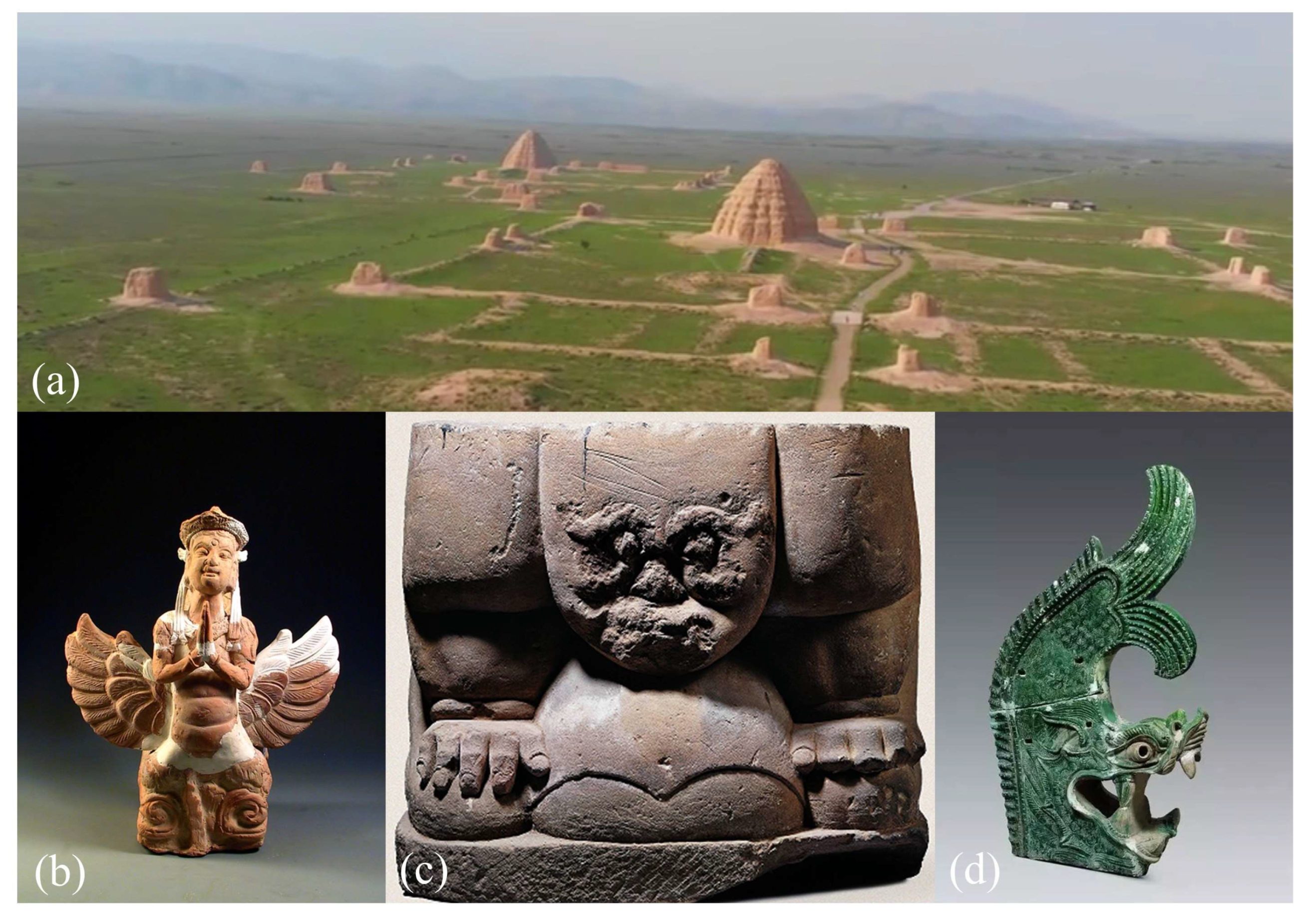

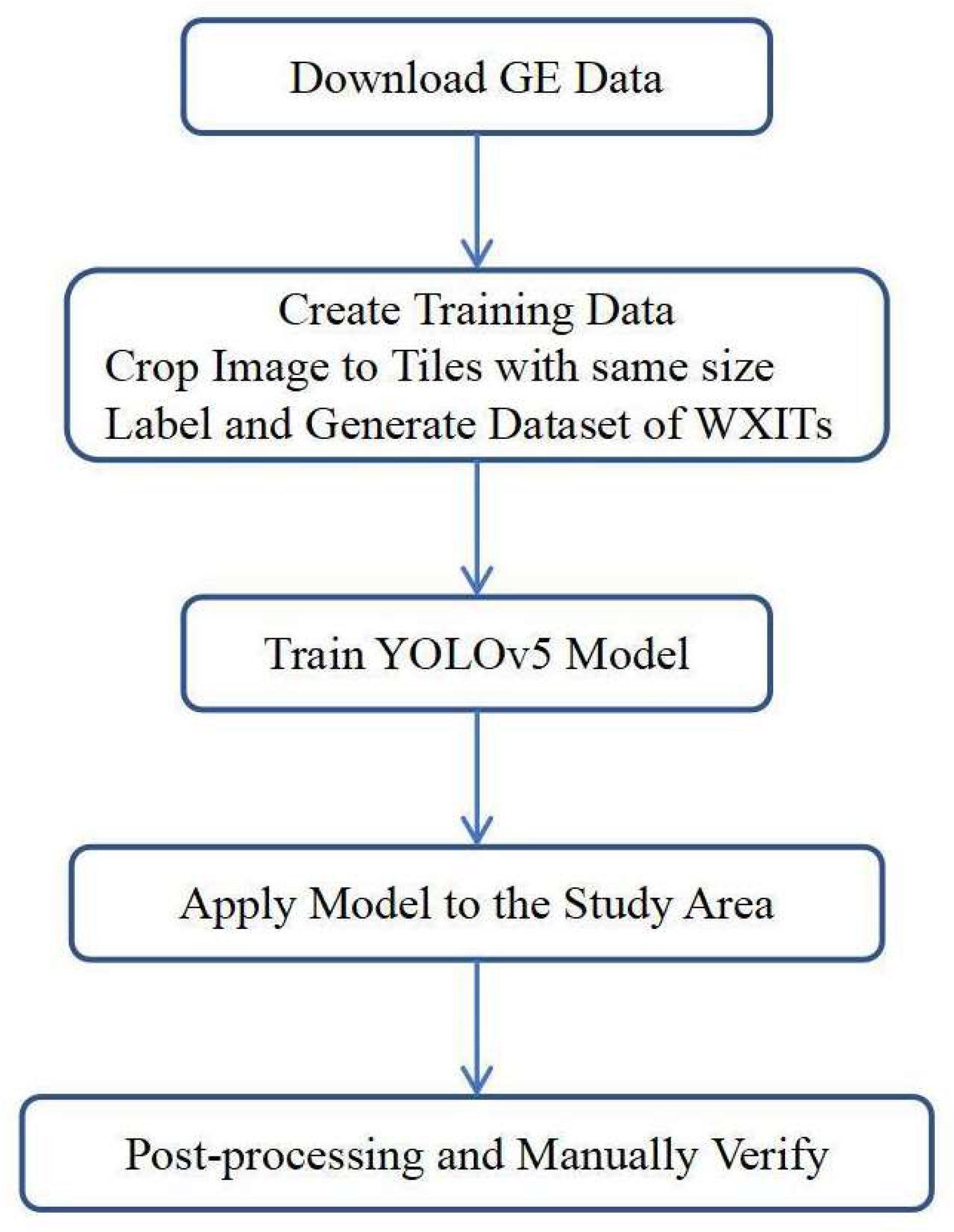

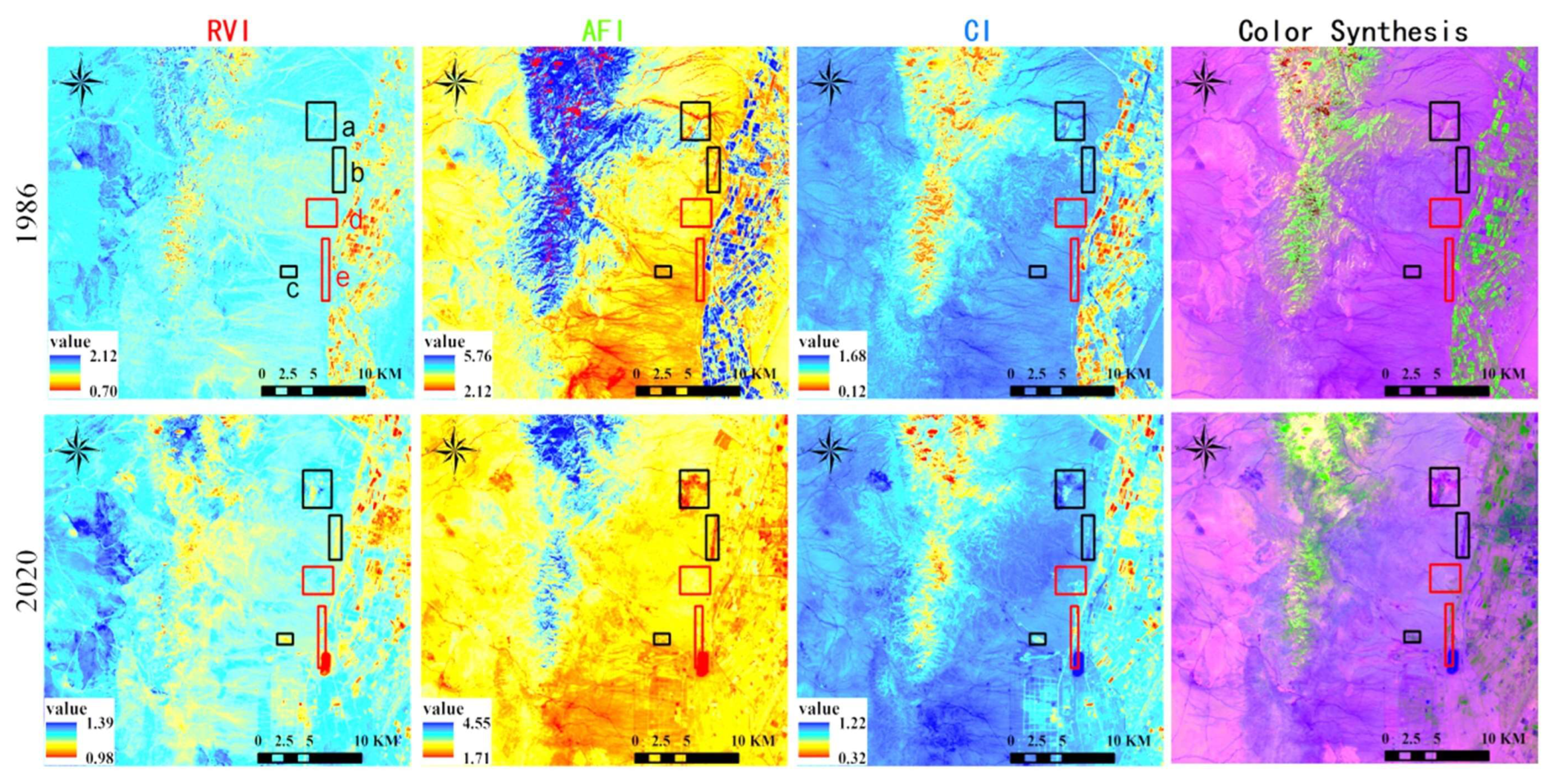
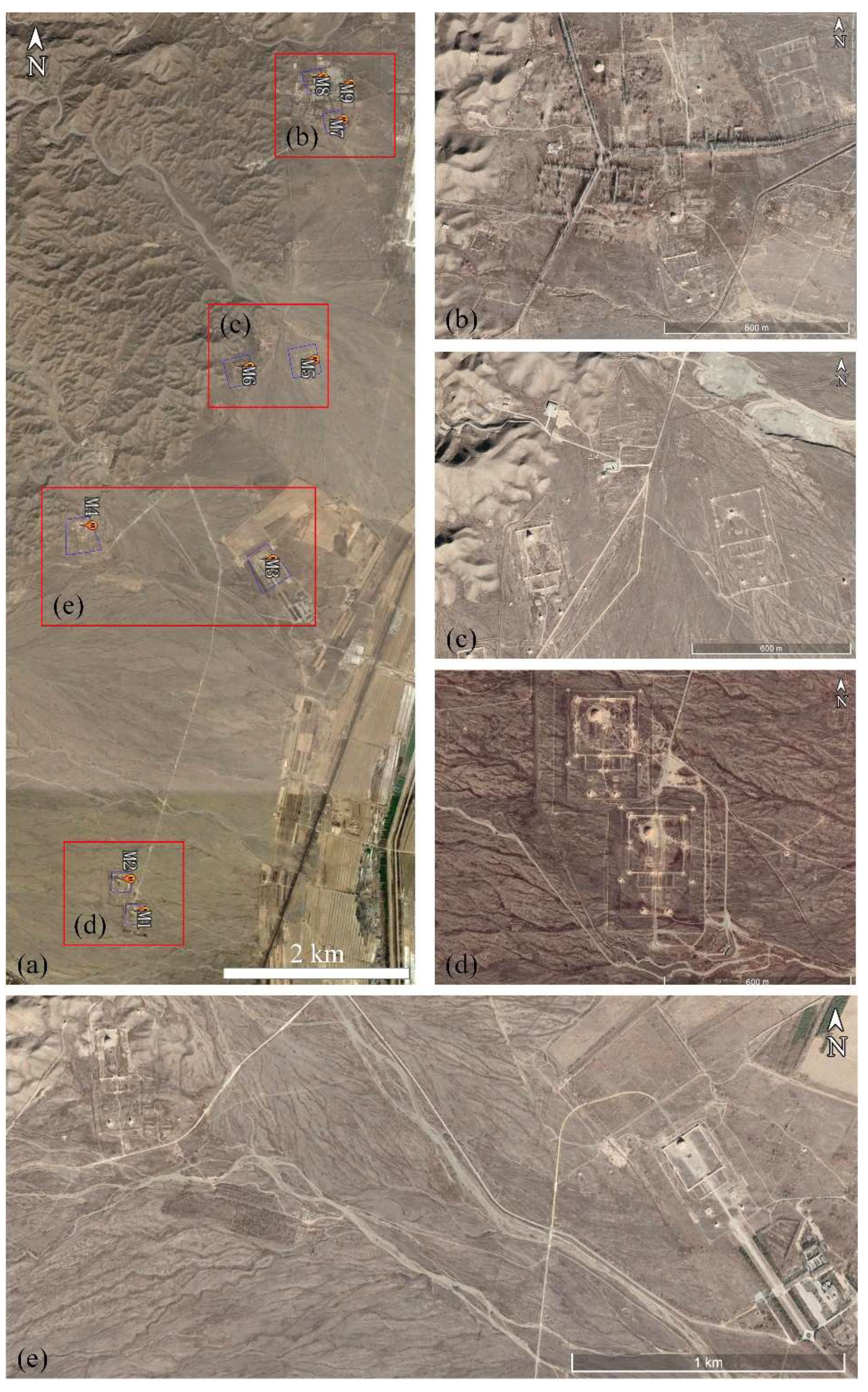

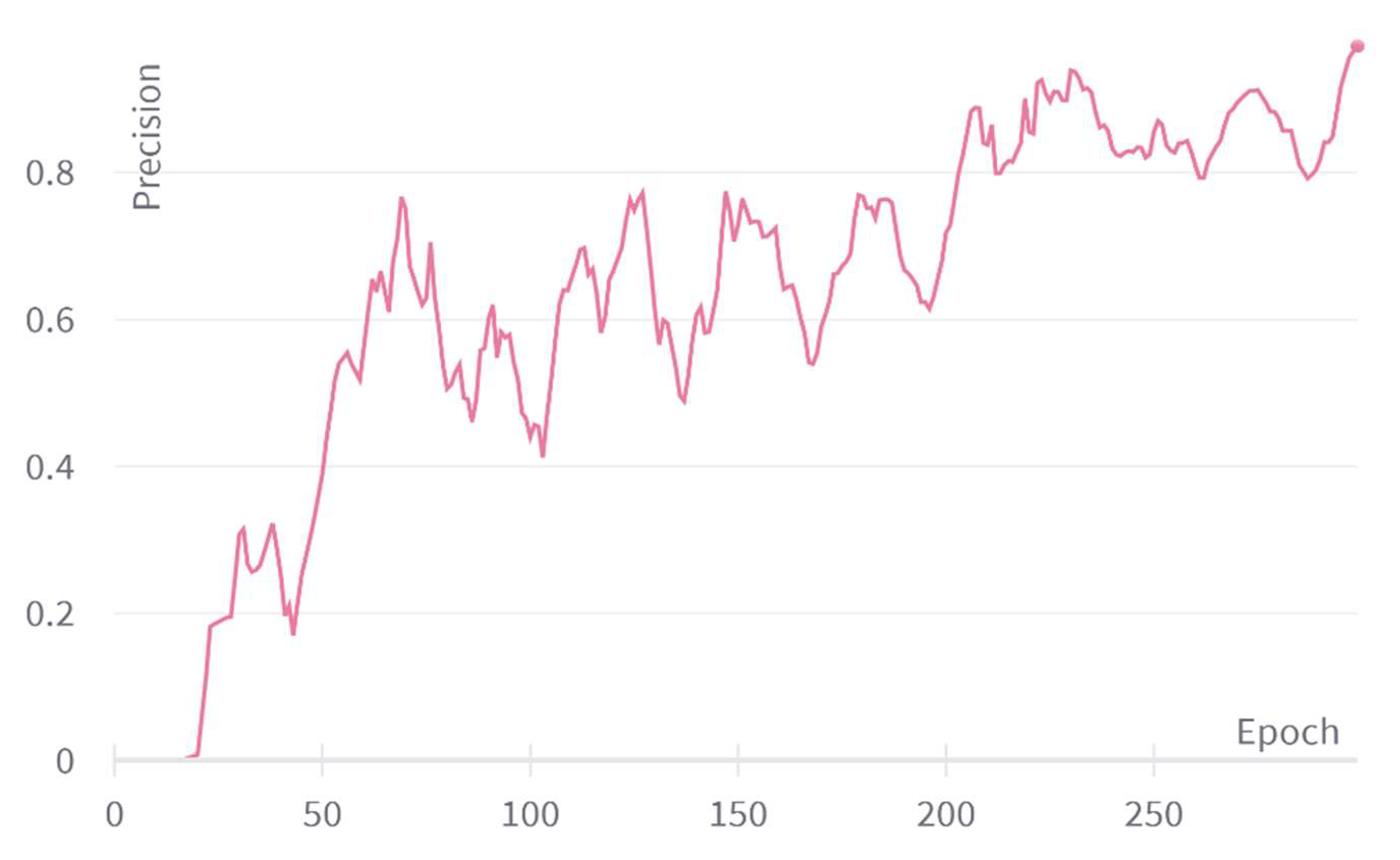
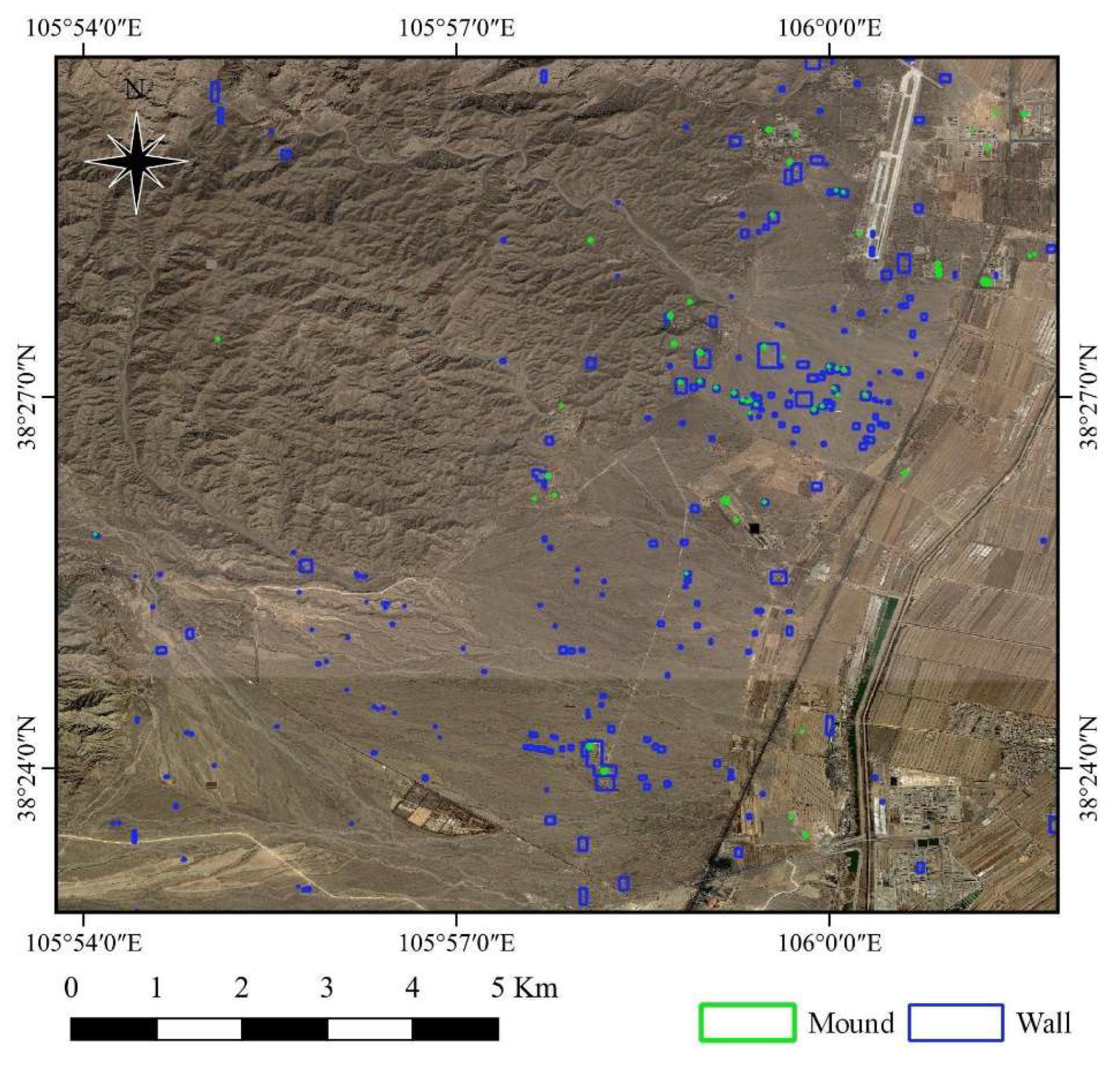

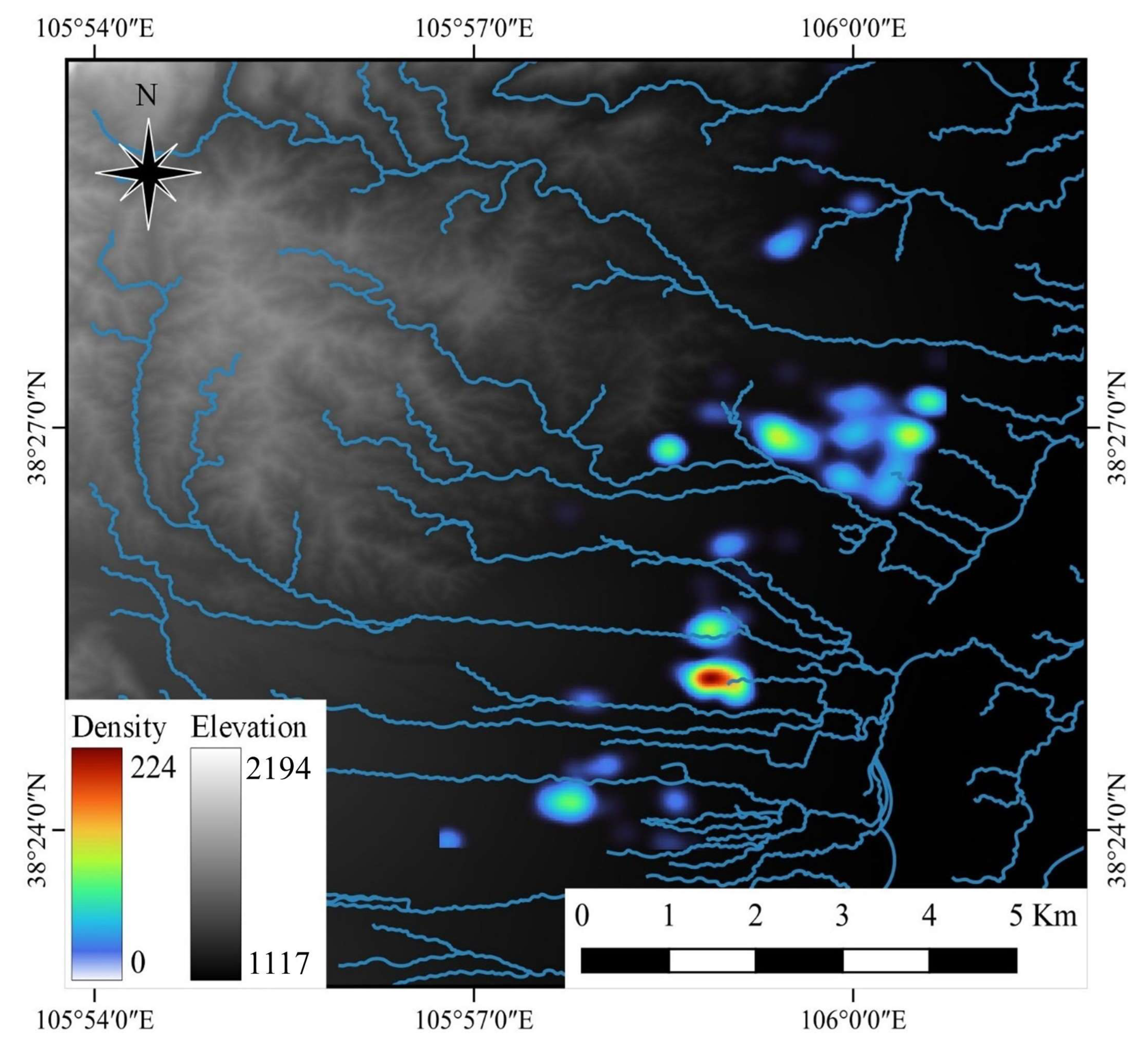
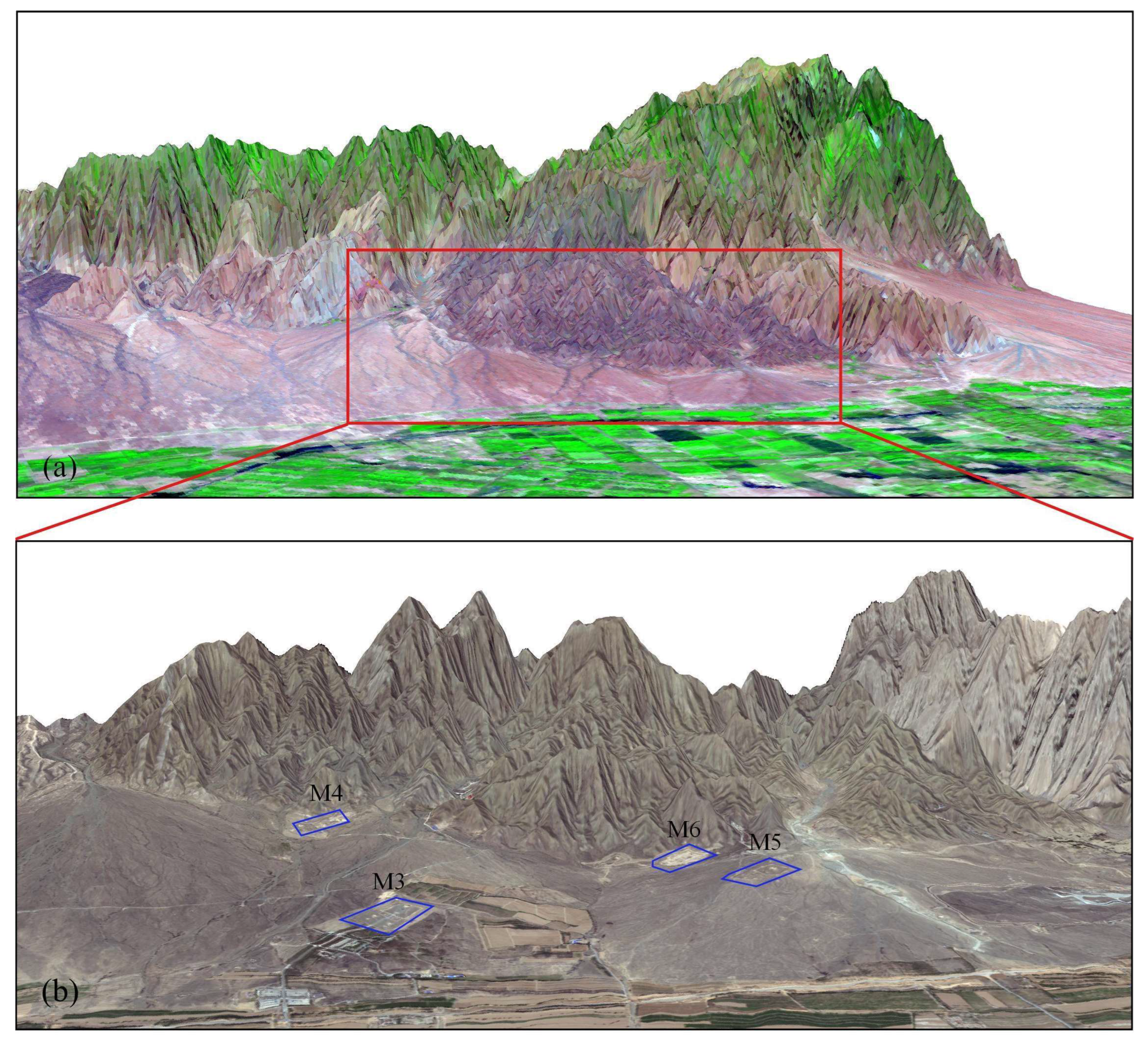

| Imaging Sensors | Spectral Wavelength/nm | Spatial Resolution/m | |
|---|---|---|---|
| GF-2 PMS | PAN | 450–900 | 0.8 |
| MS | B1-Blue: 450–520 | 3.2 | |
| B2-Green: 520–590 | |||
| B3-Red: 630–690 | |||
| B4-NIR: 770–890 |
Disclaimer/Publisher’s Note: The statements, opinions and data contained in all publications are solely those of the individual author(s) and contributor(s) and not of MDPI and/or the editor(s). MDPI and/or the editor(s) disclaim responsibility for any injury to people or property resulting from any ideas, methods, instructions or products referred to in the content. |
© 2025 by the authors. Licensee MDPI, Basel, Switzerland. This article is an open access article distributed under the terms and conditions of the Creative Commons Attribution (CC BY) license (https://creativecommons.org/licenses/by/4.0/).
Share and Cite
Ji, W.; Li, L.; Yang, J.; Hao, Y.; Luo, L. Remote Sensing Archaeology of the Xixia Imperial Tombs: Analyzing Burial Landscapes and Geomantic Layouts. Remote Sens. 2025, 17, 2395. https://doi.org/10.3390/rs17142395
Ji W, Li L, Yang J, Hao Y, Luo L. Remote Sensing Archaeology of the Xixia Imperial Tombs: Analyzing Burial Landscapes and Geomantic Layouts. Remote Sensing. 2025; 17(14):2395. https://doi.org/10.3390/rs17142395
Chicago/Turabian StyleJi, Wei, Li Li, Jia Yang, Yuqi Hao, and Lei Luo. 2025. "Remote Sensing Archaeology of the Xixia Imperial Tombs: Analyzing Burial Landscapes and Geomantic Layouts" Remote Sensing 17, no. 14: 2395. https://doi.org/10.3390/rs17142395
APA StyleJi, W., Li, L., Yang, J., Hao, Y., & Luo, L. (2025). Remote Sensing Archaeology of the Xixia Imperial Tombs: Analyzing Burial Landscapes and Geomantic Layouts. Remote Sensing, 17(14), 2395. https://doi.org/10.3390/rs17142395






